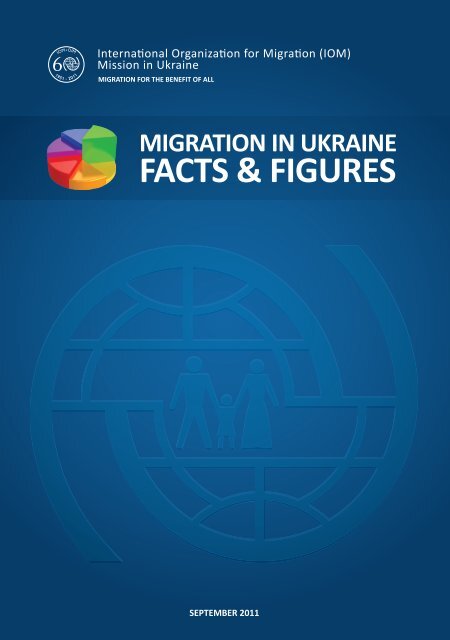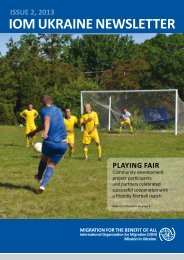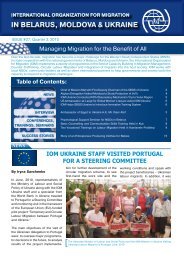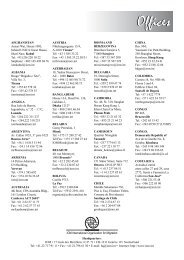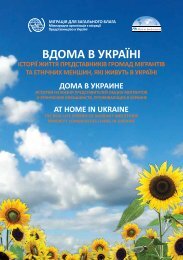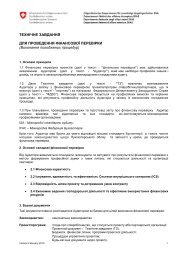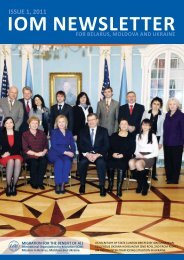Migration in Ukraine: Facts and Figures - IOM
Migration in Ukraine: Facts and Figures - IOM
Migration in Ukraine: Facts and Figures - IOM
Create successful ePaper yourself
Turn your PDF publications into a flip-book with our unique Google optimized e-Paper software.
International Organization for <strong>Migration</strong> (<strong>IOM</strong>)<br />
Mission <strong>in</strong> Ukra<strong>in</strong>e<br />
MIGRATION FOR THE BENEFIT OF ALL<br />
MIGRATION IN UKRAINE<br />
FACTS & FIGURES<br />
SEPTEMBER 2011
SEPTEMBER, 2011 SEPTEMBER, 2011<br />
Dear Reader,<br />
FOREWORD<br />
With ‘<strong>Migration</strong> <strong>in</strong> Ukra<strong>in</strong>e: <strong>Facts</strong> <strong>and</strong> <strong>Figures</strong>’, the Ukra<strong>in</strong>e Mission of the International<br />
Organization for <strong>Migration</strong> (<strong>IOM</strong>) <strong>in</strong>tends to provide you with a compilation of<br />
migration trends <strong>and</strong> statistics.<br />
While this short overview can only provide an <strong>in</strong>troduction to the complex <strong>and</strong><br />
often <strong>in</strong>ter-related topic of migration issues <strong>in</strong> Ukra<strong>in</strong>e, we have tried to the extent<br />
possible, to put the facts <strong>and</strong> figures <strong>in</strong> context <strong>and</strong> to highlight how the relevant<br />
trends have evolved over time. This appears even more important given the often<br />
limited <strong>in</strong>formation available.<br />
In l<strong>in</strong>e with <strong>IOM</strong>’s overall m<strong>and</strong>ate, this fact sheet aims at advanc<strong>in</strong>g the underst<strong>and</strong><strong>in</strong>g<br />
of the opportunities <strong>and</strong> challenges of migration <strong>in</strong> the Ukra<strong>in</strong>ian context. Maximiz<strong>in</strong>g<br />
those opportunities <strong>and</strong> m<strong>in</strong>imiz<strong>in</strong>g the challenges accompanied with migratory<br />
movements are the guid<strong>in</strong>g pr<strong>in</strong>ciples of all activities <strong>and</strong> programmes the Mission<br />
is engaged <strong>in</strong>.<br />
In do<strong>in</strong>g so, the <strong>IOM</strong> Mission <strong>in</strong> Ukra<strong>in</strong>e cont<strong>in</strong>ues fight<strong>in</strong>g traffick<strong>in</strong>g <strong>in</strong> human<br />
be<strong>in</strong>gs, assist<strong>in</strong>g the Government <strong>in</strong> deal<strong>in</strong>g with irregular migration <strong>and</strong> migration<br />
management, <strong>and</strong> creat<strong>in</strong>g migrant-<strong>in</strong>clusive health practices <strong>and</strong> policies. At the<br />
same time, <strong>IOM</strong> Ukra<strong>in</strong>e engages <strong>in</strong> explor<strong>in</strong>g <strong>and</strong> promot<strong>in</strong>g regular channels for<br />
Ukra<strong>in</strong>ian labour migrants, <strong>in</strong>tegrat<strong>in</strong>g ethnic m<strong>in</strong>orities, promot<strong>in</strong>g the benefits of<br />
cultural diversity, <strong>and</strong> counteract<strong>in</strong>g xenophobia.<br />
This overview is a dynamic document, which will be updated on a regular basis, <strong>and</strong><br />
thus, we welcome any comments, advice <strong>and</strong> new data, which you might have <strong>and</strong><br />
that may help to improve this document <strong>in</strong> the future.<br />
Manfred Profazi<br />
Chief of Mission,<br />
<strong>IOM</strong> Mission <strong>in</strong> Ukra<strong>in</strong>e<br />
Established <strong>in</strong> 1951, the International Organization<br />
for <strong>Migration</strong> (<strong>IOM</strong>) is the lead<strong>in</strong>g<br />
<strong>in</strong>ter-governmental organization <strong>in</strong> the field of<br />
migration. It works closely with governmental,<br />
<strong>in</strong>tergovernmental <strong>and</strong> non-governmental partners.<br />
<strong>IOM</strong> is committed to the pr<strong>in</strong>ciple that humane<br />
<strong>and</strong> orderly migration benefits migrants <strong>and</strong><br />
society. As an <strong>in</strong>tergovermental organization,<br />
<strong>IOM</strong> acts with its partners <strong>in</strong> the <strong>in</strong>ternational<br />
community to: assist <strong>in</strong> meet<strong>in</strong>g the<br />
operational challenges of migration; advance<br />
underst<strong>and</strong><strong>in</strong>g of migration issues; encourage<br />
UKRAINE: Middle Income Country<br />
• Population (as of 1 July 2011): 45.7 million 1<br />
Ukra<strong>in</strong>e is the 29th biggest country <strong>in</strong> the world.<br />
• Population growth<br />
(average %, 2000-2011): -0.7 annually 2<br />
The population of Ukra<strong>in</strong>e is shr<strong>in</strong>k<strong>in</strong>g by<br />
330,000 per year.<br />
• Ratio of economically active to economically<br />
<strong>in</strong>active population (2010): 1.75:1 3<br />
There is an <strong>in</strong>creas<strong>in</strong>g burden on the productive<br />
part of the population to support the upbr<strong>in</strong>g<strong>in</strong>g<br />
<strong>and</strong> pensions of the economically dependent.<br />
This directly impacts f<strong>in</strong>ancial expenditures on<br />
social security.<br />
• Unemployment rate accord<strong>in</strong>g to the<br />
ILO methodology (average 2010): 8% of<br />
labour force 4<br />
The unemployment rate rose from 6.8% <strong>in</strong> 2006<br />
to 8.1% <strong>in</strong> 2010. In 2010, 545,000 Ukra<strong>in</strong>ian<br />
<strong>IOM</strong><br />
social <strong>and</strong> economic development through<br />
migration; <strong>and</strong> uphold the human dignity <strong>and</strong><br />
well-be<strong>in</strong>g of migrants.<br />
<strong>IOM</strong> has been operat<strong>in</strong>g <strong>in</strong> Ukra<strong>in</strong>e s<strong>in</strong>ce 1996,<br />
assist<strong>in</strong>g the Government <strong>in</strong> deal<strong>in</strong>g with the<br />
challeng<strong>in</strong>g aspects of migration <strong>and</strong><br />
promot<strong>in</strong>g the positive contributions of<br />
migrants to society. <strong>IOM</strong> works <strong>in</strong> the areas of<br />
Counter-Traffick<strong>in</strong>g <strong>in</strong> Human Be<strong>in</strong>gs,<br />
Immigration <strong>and</strong> Border Management, Labour<br />
<strong>and</strong> Facilitated <strong>Migration</strong>, Migrant Health <strong>and</strong><br />
<strong>Migration</strong> Movement Management.<br />
General Information<br />
citizens were recorded as unemployed. If<br />
employment abroad was impossible, the<br />
unemployment rate <strong>in</strong> Ukra<strong>in</strong>e <strong>in</strong> 2008 is<br />
estimated to have been 1.5 times higher 5 .<br />
Immigration can be seen as a viable alternative<br />
to reduce pressure on the local labour market.<br />
• GDP (2010): USD 136.8 billion 6 <strong>in</strong> current prices<br />
In 2008, Ukra<strong>in</strong>e's economy was ranked 45th <strong>in</strong><br />
the world accord<strong>in</strong>g to GDP (nom<strong>in</strong>al). However,<br />
as a result of the economic crisis the country’s GDP<br />
contracted by 15% <strong>in</strong> 2009, with fixed <strong>in</strong>vestments<br />
fall<strong>in</strong>g by 46%. S<strong>in</strong>ce October 2008, the national<br />
currency Hryvnia has lost about 40% of its value<br />
aga<strong>in</strong>st the US Dollar 7 (as of 2011).<br />
• Foreign direct <strong>in</strong>vestment (2010):<br />
USD 5.5 billion 8<br />
The net foreign direct <strong>in</strong>vestment (FDI) <strong>in</strong><br />
Ukra<strong>in</strong>e <strong>in</strong>creased by nearly 11% <strong>in</strong> 2010 from<br />
2009 (USD 5 billion) 9 .<br />
© All rights reserved, <strong>IOM</strong> Ukra<strong>in</strong>e (2011)<br />
Waiver: <strong>Figures</strong> <strong>and</strong> statements presented <strong>in</strong> this document do not necessarily reflect the views of the International Organization for <strong>Migration</strong> (<strong>IOM</strong>).<br />
8 Mykhailivska St., Kyiv, 01001, Ukra<strong>in</strong>e<br />
Tel.: +38 044 568 50 15 Fax: +38 044 568 50 16<br />
e-mail: iomkiev@iom.<strong>in</strong>t<br />
www.iom.org.ua<br />
e-mail: iomkiev@iom.<strong>in</strong>t<br />
www.iom.org.ua<br />
8 Mykhailivska St., Kyiv, 01001, Ukra<strong>in</strong>e<br />
Tel.: +38 044 568 50 15 Fax: +38 044 568 50 16
SEPTEMBER, 2011 SEPTEMBER, 2011<br />
Emigration<br />
Stock of emigrants*:<br />
6.5 million 10 (expatriate Ukra<strong>in</strong>ians accord<strong>in</strong>g to the census of<br />
the population of the foreign countries where they reside).<br />
*Persons, who reside not <strong>in</strong> the counries of their orig<strong>in</strong>.<br />
Stock of emigrants as percentage of population:<br />
14.4%.<br />
Top dest<strong>in</strong>ation countries: the Russian<br />
Federation, Germany, the United States,<br />
Israel, Czech Republic, Hungary, Pol<strong>and</strong>.<br />
Immigration<br />
Stock of immigrants:<br />
1. 198,325 (number of immigrants registered by the M<strong>in</strong>isry<br />
of Internal Affairs of Ukra<strong>in</strong>e <strong>in</strong> 2010) 11<br />
2. 5.3 million* (residents of Ukra<strong>in</strong>e born abroad, accord<strong>in</strong>g<br />
to the census of the population <strong>in</strong> 2001) 12<br />
*92% of them arrived from post-Soviet area, <strong>and</strong> 85% - before the USSR breakup, <strong>in</strong> other words<br />
they were <strong>in</strong>ternal migrants then.<br />
Top countries of orig<strong>in</strong>: the Russian Federation,<br />
Moldova, Uzbekistan, Belarus, Georgia, Armenia,<br />
Azerbaijan.<br />
MAP 4. GEOGRAPHICAL DISTRIBUTION OF UKRAINIAN LABOUR MIGRANTS BY REGIONS OF ORIGIN 17<br />
Labour <strong>Migration</strong><br />
FIGURE 1. MAIN DESTINATION COUNTRIES OF UKRAINIAN<br />
LABOUR MIGRANTS WITH GENDER DISTRIBUTION (2005 - 2008) 13<br />
50%<br />
40%<br />
30%<br />
20%<br />
Women<br />
Men<br />
FIGURE 2. GENDER BREAKDOWN<br />
OF UKRAINIAN LABOUR MIGRANTS 14<br />
67% Men<br />
Very High<br />
High<br />
Average<br />
Low<br />
Very low<br />
10%<br />
0<br />
Russian<br />
Federation<br />
EU*<br />
Italy<br />
Czech<br />
Republic<br />
Pol<strong>and</strong><br />
*top six EU countries: Italy, Czech Republic, Pol<strong>and</strong>, Hungary, Spa<strong>in</strong>, Portugal.<br />
FIGURE 3. MAIN EMPLOYMENT AREAS OF UKRAINIAN LABOUR MIGRANTS 15<br />
5% Other k<strong>in</strong>ds of work<br />
17% Domestic care<br />
9% Wholesale <strong>and</strong> retail trade<br />
9% Agricultural sector<br />
6% Industry<br />
33% Women<br />
The degree of economic divergence between Ukra<strong>in</strong>e's regions is significant. For <strong>in</strong>stance,<br />
per capita <strong>in</strong>come <strong>in</strong> the Donetsk Region is USD 683 (<strong>in</strong> the first quarter of 2011), which is<br />
20% higher than the average <strong>in</strong>come <strong>in</strong> Ukra<strong>in</strong>e (USD 550), while the <strong>in</strong>come <strong>in</strong> the Chernivtsi<br />
Region (USD 352) is 37% less than the average. These economic disparities <strong>and</strong> asymmetric<br />
development paths between the regions have to be perceived as one of the factors<br />
expla<strong>in</strong><strong>in</strong>g the current geographical distribution pattern 18<br />
(see Map 4). Other key factors<br />
<strong>in</strong>clude EU border proximity, established migration networks, <strong>and</strong> cultural ties.<br />
Education<br />
54% Construction<br />
The dom<strong>in</strong>ant types of economic activity among Ukra<strong>in</strong>ian labour migrants are construction,<br />
more prevalent among men, <strong>and</strong> domestic care, more common among women. It is estimated<br />
that approximately one quarter of all migrants are work<strong>in</strong>g abroad with an irregular status 16 .<br />
Ukra<strong>in</strong>ian labour migration, at least to a certa<strong>in</strong> extent, can be characterized by<br />
‘bra<strong>in</strong> waste’, <strong>in</strong> light of the exist<strong>in</strong>g mismatch between migrants’ skills <strong>and</strong><br />
occupied positions 19 . Only few of the migrants manage to f<strong>in</strong>d jobs abroad<br />
correspond<strong>in</strong>g to their qualification levels, regardless of their education, almost all<br />
of them are work<strong>in</strong>g <strong>in</strong> low skilled jobs 20 . This disparity is further evidenced when<br />
data on migrants’ areas of employment abroad (see Figure 3) are juxtaposed with<br />
their education level (see Figure 5).<br />
8 Mykhailivska St., Kyiv, 01001, Ukra<strong>in</strong>e<br />
Tel.: +38 044 568 50 15 Fax: +38 044 568 50 16<br />
e-mail: iomkiev@iom.<strong>in</strong>t<br />
www.iom.org.ua<br />
e-mail: iomkiev@iom.<strong>in</strong>t<br />
www.iom.org.ua<br />
8 Mykhailivska St., Kyiv, 01001, Ukra<strong>in</strong>e<br />
Tel.: +38 044 568 50 15 Fax: +38 044 568 50 16
SEPTEMBER, 2011 SEPTEMBER, 2011<br />
FIGURE 5. EDUCATION LEVEL OF UKRAINIAN LABOUR MIGRANTS 21<br />
59%<br />
59% Complete secondary<br />
17% Basic or <strong>in</strong>complete higher<br />
14% Complete higher<br />
10% Primary or <strong>in</strong>complete secondary<br />
17%<br />
10%<br />
14%<br />
% population<br />
25<br />
20<br />
15<br />
10<br />
5<br />
0<br />
FIGURE 7. THE PROPORTION OF<br />
POPULATION AGED 65+ (2000 & 2025) 24<br />
2000<br />
2025<br />
Unemployment <strong>and</strong> <strong>Migration</strong><br />
Ag<strong>in</strong>g is an <strong>in</strong>evitable demographic<br />
trend <strong>and</strong> Ukra<strong>in</strong>e is projected to<br />
experience an <strong>in</strong>crease <strong>in</strong> the<br />
percentage of Ukra<strong>in</strong>ians of<br />
retirement age (aged 65 or over) from<br />
14% to 20.5% 24 . This development will<br />
have significant consequences for the<br />
labour force, who will have to support<br />
the grow<strong>in</strong>g number of pensioners<br />
<strong>and</strong> people <strong>in</strong> need of health care.<br />
Demographics<br />
The population development of Ukra<strong>in</strong>e is characterized by demographic decl<strong>in</strong>e. Between 1991<br />
<strong>and</strong> 2010 the total population decl<strong>in</strong>ed from 51.7 million to 45.9 million, reflect<strong>in</strong>g a sharp decl<strong>in</strong>e<br />
<strong>in</strong> birth rate <strong>and</strong> a negative migration balance. This trend is expected to cont<strong>in</strong>ue, imply<strong>in</strong>g that<br />
the overall population will decl<strong>in</strong>e by another 10 million until 2050. By 2050, nearly half of the<br />
population will be more than 45 years old 22 .<br />
46 mln<br />
44 mln<br />
42 mln<br />
40 mln<br />
38 mln<br />
36 mln<br />
34 mln<br />
32 mln<br />
30 mln<br />
FIGURE 6. POPULATION DECLINE IN UKRAINE 2010–2050 23<br />
2010 2015 2020 2025 2030 2035 2040 2045 2050<br />
Migrant-non-migrant wage differential: the average migrant wage abroad was USD 820 25 <strong>in</strong><br />
2008 , which was almost 3 times higher than the average salary <strong>in</strong> Ukra<strong>in</strong>e (USD 281 26 ). The<br />
ma<strong>in</strong> migration push factors for Ukra<strong>in</strong>ian labour migrants are the improvement of their<br />
liv<strong>in</strong>g st<strong>and</strong>ards <strong>and</strong> the prospect of higher salaries (over 56%); whilst unemployment is a<br />
marg<strong>in</strong>al variable (less than 7%) 27 . However <strong>in</strong>come differentials are not the sole<br />
motivation factor for migration; the decision process <strong>in</strong>cludes non-fiscal variables such as<br />
social preferences <strong>and</strong> cultural values 28 .<br />
billion USD<br />
10<br />
8<br />
6<br />
4<br />
2<br />
0<br />
Remittances<br />
FIGURE 8.<br />
FDI<br />
ODA<br />
Net FDI (2010): 5.5 billion USD 29<br />
Remittances (2010): 5.2 billion USD 30<br />
Official Development Assistance (2009): 0.667 billion USD 31<br />
Migrant Monetary Transfers to Ukra<strong>in</strong>e (Remittances)<br />
Remittances to Ukra<strong>in</strong>e are nearly equivalent<br />
to Foreign Direct Investment (FDI) <strong>and</strong> almost<br />
eight times higher than Official Development<br />
Assistance (ODA). Hypothetical models<br />
estimate that the Ukra<strong>in</strong>ian economy would<br />
have lost about 7% of its potential without the<br />
stimulat<strong>in</strong>g effects of migrant transfers 32<br />
<strong>and</strong><br />
that a 10% <strong>in</strong>crease <strong>in</strong> per capita remittances<br />
leads to a 3.5% decl<strong>in</strong>e <strong>in</strong> the share of people<br />
liv<strong>in</strong>g <strong>in</strong> poverty 33 . The biggest share of<br />
remittances is used for liv<strong>in</strong>g expenses (73%)<br />
<strong>and</strong> consumer goods (26%), whilst only 3.3%<br />
are used for sett<strong>in</strong>g up a bus<strong>in</strong>ess 34 . One per<br />
cent reduction <strong>in</strong> transaction costs raises<br />
recorded remittances by 14-23% 35 .<br />
8 Mykhailivska St., Kyiv, 01001, Ukra<strong>in</strong>e<br />
Tel.: +38 044 568 50 15 Fax: +38 044 568 50 16<br />
e-mail: iomkiev@iom.<strong>in</strong>t<br />
www.iom.org.ua<br />
e-mail: iomkiev@iom.<strong>in</strong>t<br />
www.iom.org.ua<br />
8 Mykhailivska St., Kyiv, 01001, Ukra<strong>in</strong>e<br />
Tel.: +38 044 568 50 15 Fax: +38 044 568 50 16
SEPTEMBER, 2011 SEPTEMBER, 2011<br />
Ukra<strong>in</strong>e receives the largest shares of remittances from Russia, United States, Germany,<br />
Greece, Italy, <strong>and</strong> the United K<strong>in</strong>gdom 36 , which <strong>in</strong>dicates that it is not only Ukra<strong>in</strong>ian labour<br />
migrants mak<strong>in</strong>g transfers but also the diaspora (see diaspora chart below).<br />
Ukra<strong>in</strong>ian Diaspora<br />
3,000,000<br />
2,500,000<br />
2,000,000<br />
1,500,000<br />
1,000,000<br />
500,000<br />
FIGURE 9. UKRAINIAN DIASPORA (STOCK, 2009) 37<br />
The presented statistics refer only to<br />
registered foreign nationals <strong>in</strong> Ukra<strong>in</strong>e,<br />
whilst the real figure is beleived to be<br />
higher. The overall trend demonstrates<br />
a consistent decrease s<strong>in</strong>ce 2006.<br />
Students comprise an important<br />
segment among the foreign<br />
population <strong>in</strong> Ukra<strong>in</strong>e. Accord<strong>in</strong>g to<br />
the M<strong>in</strong>istry of Education, Science,<br />
Youth <strong>and</strong> Sports the number of<br />
foreign students has been constantly<br />
ris<strong>in</strong>g – almost 47,000 foreign students<br />
were study<strong>in</strong>g <strong>in</strong> Ukra<strong>in</strong>e <strong>in</strong> 2010,<br />
which represents an 56% rise relative<br />
to the figures for 2002 (22,022).<br />
250,000<br />
200,000<br />
150,000<br />
100,000<br />
50,000<br />
0<br />
Foreigners Resid<strong>in</strong>g <strong>in</strong> Ukra<strong>in</strong>e<br />
FIGURE 11. NUMBER OF FOREIGN<br />
CITIZENS REGISTERED IN UKRAINE (2003-2010) 38<br />
Russia<br />
Moldova<br />
Uzbekistan<br />
Other<br />
Total<br />
2003 2004 2005 2006 2007 2008 2009 2010<br />
Traffick<strong>in</strong>g <strong>in</strong> Human Be<strong>in</strong>gs<br />
0<br />
Russia USA Canada Moldova Kazakhstan<br />
Other<br />
FIGURE 12. VICTIMS OF TRAFFICKING ASSISTED BY <strong>IOM</strong> IN UKRAINE (2000-2010)<br />
Ukra<strong>in</strong>e has one of the largest diaspora <strong>in</strong> the world, many of them ma<strong>in</strong>ta<strong>in</strong><strong>in</strong>g<br />
cultural <strong>and</strong> economic l<strong>in</strong>kages with the homel<strong>and</strong>.<br />
<strong>in</strong>queries<br />
50,000<br />
45,000<br />
40,000<br />
35,000<br />
30,000<br />
25,000<br />
20,000<br />
15,000<br />
10,000<br />
5,000<br />
0<br />
FIGURE 9. INFORMATION OF MOST INTEREST TO<br />
POTENTIAL MIGRANTS FROM UKRAINE (2006-2011) *<br />
37%<br />
30%<br />
16%<br />
11%<br />
Employment<br />
Contacts of organizations<br />
Other<br />
Traffick<strong>in</strong>g <strong>in</strong>fo<br />
Tourism/private visit<br />
*Based on the data collected by a network of Centres for Migrant Advice; most potentional migrants are <strong>in</strong>terested <strong>in</strong> employment abroad<br />
<strong>and</strong> contact <strong>in</strong>formation of support<strong>in</strong>g organizations.<br />
6%<br />
1,200<br />
1,000<br />
800<br />
600<br />
400<br />
200<br />
0<br />
42<br />
Male<br />
Female<br />
Gender unavailable<br />
254<br />
332<br />
525<br />
626<br />
1,121<br />
937<br />
828 820<br />
773<br />
1,085<br />
2000 2001 2002 2003 2004 2005 2006 2007 2008 2009 2010<br />
Ukra<strong>in</strong>e rema<strong>in</strong>s one of the ma<strong>in</strong> countries of orig<strong>in</strong> for victims of traffick<strong>in</strong>g (VoTs). Out of<br />
the estimated 110,000 Ukra<strong>in</strong>ian citizens who have become VoTs s<strong>in</strong>ce 1991 (average<br />
5,500/annum) 39 , <strong>IOM</strong> identified/assisted 7% (over 7,500). Numerous new trends are<br />
emerg<strong>in</strong>g, <strong>in</strong>clud<strong>in</strong>g an <strong>in</strong>crease <strong>in</strong> labour exploitation; the risk group for traffick<strong>in</strong>g<br />
exp<strong>and</strong><strong>in</strong>g from young women (15-24) to women <strong>and</strong> men of all ages; a rise <strong>in</strong> the number<br />
of identified child victims; <strong>and</strong> an <strong>in</strong>creas<strong>in</strong>g number of foreign VoTs.<br />
8 Mykhailivska St., Kyiv, 01001, Ukra<strong>in</strong>e<br />
Tel.: +38 044 568 50 15 Fax: +38 044 568 50 16<br />
e-mail: iomkiev@iom.<strong>in</strong>t<br />
www.iom.org.ua<br />
e-mail: iomkiev@iom.<strong>in</strong>t<br />
www.iom.org.ua<br />
8 Mykhailivska St., Kyiv, 01001, Ukra<strong>in</strong>e<br />
Tel.: +38 044 568 50 15 Fax: +38 044 568 50 16
SEPTEMBER, 2011 SEPTEMBER, 2011<br />
FIGURE 13. TOP DESTINATIONS OF VICTIMS OF TRAFFICKING* (2000-2010) 40<br />
FIGURE 15. IRREGULAR MIGRANTS APPREHENDED INSIDE UKRAINE (2003-2010) 42<br />
4% Italy 4% Ukra<strong>in</strong>e<br />
5% Czech Republic<br />
14% Pol<strong>and</strong><br />
24% Other Countries<br />
20,000<br />
18,000<br />
16,000<br />
14,000<br />
12,000<br />
16% Turkey<br />
*Victims of traffick<strong>in</strong>g assisted by <strong>IOM</strong> Ukra<strong>in</strong>e<br />
33% Russian Federation<br />
10,000<br />
8,000<br />
6,000<br />
4,000<br />
2,000<br />
0<br />
2003 2004 2005 2006 2007 2008 2009 2010<br />
Total<br />
Russia<br />
Azerbaijan<br />
Moldova<br />
Other<br />
Irregular <strong>Migration</strong><br />
In recent years, Ukra<strong>in</strong>e has witnessed a shift<strong>in</strong>g trend <strong>in</strong> ma<strong>in</strong> countries of orig<strong>in</strong> of<br />
irregular migrants detected at the border, with dom<strong>in</strong>ant nationalities chang<strong>in</strong>g from Asia<br />
to the newly <strong>in</strong>dependent states (CIS region).<br />
45,000<br />
40,000<br />
35,000<br />
30,000<br />
25,000<br />
20,000<br />
15,000<br />
10,000<br />
5,000<br />
FIGURE 14. NUMBER AND NATIONALITY OF MIGRANTS WHO WERE NOT ALLOWED TO ENTER<br />
UKRAINE, INCLUDING IRREGULAR MIGRANTS (2005 - 2010) 41<br />
0<br />
Total<br />
Moldova<br />
Uzbekistan<br />
Azerbaijan<br />
Other<br />
2005 2006 2007 2008 2009 2010<br />
Irregular migrants apprehended <strong>in</strong>side the country make up almost 50% of those detected at the<br />
border, which <strong>in</strong>dicates a need for an <strong>in</strong>tegrated migration management approach shift<strong>in</strong>g beyond<br />
a border control focus.<br />
Detention<br />
600<br />
550<br />
500<br />
450<br />
400<br />
350<br />
300<br />
250<br />
200<br />
FIGURE 16. IRREGULAR MIGRANTS DETAINED IN UKRAINE (2009-2011) 43<br />
574<br />
536<br />
490<br />
453<br />
514<br />
475<br />
478<br />
396<br />
427<br />
376<br />
324<br />
S<strong>in</strong>ce 2009 the general trend signifies a decrease <strong>in</strong> the number of irregular migrants <strong>in</strong> detention,<br />
which is l<strong>in</strong>ked to the decl<strong>in</strong><strong>in</strong>g number of non-CIS (ma<strong>in</strong>ly Asian) third country nationals enter<strong>in</strong>g<br />
Ukra<strong>in</strong>e irregularly.<br />
338<br />
Apr'09 Jun'09 Aug'09 Oct'09 Dec'09 Feb'10 Apr'10 Jun'10 Aug'10 Oct'10 Dec'10 Feb'11<br />
329<br />
369<br />
469<br />
376<br />
365<br />
401<br />
381<br />
401<br />
218<br />
358<br />
216<br />
8 Mykhailivska St., Kyiv, 01001, Ukra<strong>in</strong>e<br />
Tel.: +38 044 568 50 15 Fax: +38 044 568 50 16<br />
e-mail: iomkiev@iom.<strong>in</strong>t<br />
www.iom.org.ua<br />
e-mail: iomkiev@iom.<strong>in</strong>t<br />
www.iom.org.ua<br />
8 Mykhailivska St., Kyiv, 01001, Ukra<strong>in</strong>e<br />
Tel.: +38 044 568 50 15 Fax: +38 044 568 50 16
References<br />
1. State Statistics Committee of<br />
Ukra<strong>in</strong>e (SSC), 2011<br />
2. SSC, 2011<br />
3. SSC, 2011<br />
4. SSC, 2011<br />
5. Ukra<strong>in</strong>ian Centre for Social Reforms<br />
(UCSR), SSC, “Ukra<strong>in</strong>ian External<br />
Labour <strong>Migration</strong>”, 2009<br />
6. SSC, Express Issue No 77, dd. 31 March<br />
2011<br />
7. World Bank, 2010<br />
8. SSC, 2011<br />
9. SSC, 2011<br />
10. World Bank Factbook (WBF), 2011;<br />
O. Malynovska, National Institute of<br />
Strategic Studies, 2011<br />
11. M<strong>in</strong>istry of Internal Affairs of Ukra<strong>in</strong>e<br />
(MOI), 2010<br />
12. UNPD, 2009; O. Malynovska, National<br />
Institute of Strategic Studies, 2011<br />
13. UCSR, SSC, “Ukra<strong>in</strong>ian External Labour<br />
<strong>Migration</strong>”, 2009<br />
14. UCSR, SSC, “Ukra<strong>in</strong>ian External Labour<br />
<strong>Migration</strong>”, 2009<br />
15. UCSR, SSC, “Ukra<strong>in</strong>ian External Labour<br />
<strong>Migration</strong>”, 2009 (<strong>in</strong>cludes regular <strong>and</strong><br />
irregular migrants)<br />
16. UCSR, SSC, “Ukra<strong>in</strong>ian External Labour<br />
<strong>Migration</strong>”, 2009<br />
17. UCSR, SSC, “Ukra<strong>in</strong>ian External Labour<br />
<strong>Migration</strong>”, 2009<br />
18. M. Hoffman & D. Reichel, “Ukra<strong>in</strong>ian<br />
<strong>Migration</strong>: An analysis of migration<br />
movements to, through <strong>and</strong> from<br />
Ukra<strong>in</strong>e”, 2011<br />
19. O. Malynovska, “International<br />
migration <strong>in</strong> contemporary Ukra<strong>in</strong>e:<br />
Trends <strong>and</strong> policy”, 2004<br />
20. European Tra<strong>in</strong><strong>in</strong>g Centre (ETF), 2009<br />
21. UCSR, SSC, “Ukra<strong>in</strong>ian External Labour<br />
<strong>Migration</strong>”, 2009<br />
22. UNDESA, 2009<br />
23. M. Hoffman & D. Reichel, “Ukra<strong>in</strong>ian<br />
<strong>Migration</strong>: An analysis of migration<br />
movements to, through <strong>and</strong> from<br />
Ukra<strong>in</strong>e”, 2011<br />
24. World Bank, 2007<br />
25. UCSR, SSC, “Ukra<strong>in</strong>ian External Labour<br />
<strong>Migration</strong>”, 2009<br />
26. SSC, 2011<br />
27. ETF, 2009<br />
28. A. Manssoor, IBRD/World Bank,<br />
“<strong>Migration</strong> <strong>and</strong> Remittances: Eastern<br />
Europe <strong>and</strong> the Former Soviet<br />
Union”, 2007<br />
29. SSC, 2011<br />
30. WBF, 2011<br />
31. Organization for Economic<br />
Co-operation <strong>and</strong> Development<br />
(OECD), 2011<br />
32. Centre for Social <strong>and</strong> Economic<br />
Research (CASE), 2008<br />
33. World Bank, 2010<br />
34. ETF, 2009<br />
35. C. Freund (World Bank), N.Spatafora<br />
(IMF), 2008<br />
36. National Bank of Ukra<strong>in</strong>e, 2010<br />
37. M<strong>in</strong>istry of Foreign Affairs of<br />
Ukra<strong>in</strong>e, 2010<br />
38. MOI, 2010<br />
39. <strong>IOM</strong>, 2011<br />
40. <strong>IOM</strong>, 2011<br />
41. State Border Guard Service of Ukra<strong>in</strong>e<br />
(SBGS), 2011<br />
42. MOI, 2011<br />
43. MOI <strong>and</strong> SBGS , 2009-2011; data<br />
collected from four ma<strong>in</strong> migrant<br />
hold<strong>in</strong>g facilities.<br />
We are <strong>in</strong>terested <strong>in</strong> your op<strong>in</strong>ion — please provide your comments<br />
to this <strong>Facts</strong> & <strong>Figures</strong> brochure (iomkiev@iom.<strong>in</strong>t).


